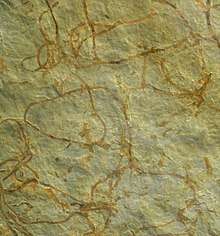Vendotaenid
Vendotaenids are ribbon-shaped, carbonaceous, Precambrian macrofossils.[2] They are thought to represent giant sulfide-reducing bacteria, similar to Thiomargarita.[2] Many form genera, including Vendotaenida, have been described.[3]
| Vendotaenid | |
|---|---|
 | |
| Scientific classification | |
| Genera[1] | |
|
Morphology
The fossils reach around 15 cm in length and are around a millimetre in width.[2]
Affinity
Originally interpreted as brown algae, the fossils are now thought to represent sulfide-reducing bacteria.[2]
Occurrence
The carbonaceous fossils, which can be extracted by HF dissolution, are found in precambrian to Early Cambrian rocks, dating from approx. 650 to 530 million years ago.[2]
gollark: Yes, they can technically workaround some of the pure horror of this, but it's going to be much more annoying than not doing that.
gollark: Imagine a company is using brain[DATA EXPUNGED] or something.
gollark: You can only avoid bees to a point; they strike at night and you'll never see them coming.
gollark: Yes. But there are differences in bee density.
gollark: Lol implicit typecasting stuff (JS).
See also
References
- Tewari, Vinod (January 1999). "Vendotaenids: Earliest Megasopic Multicellular Algae On Earth". Wadia Institute of Himalayan Geology. 20: 77–85.
- Vidal, G. (1989). "Are late Proterozoic carbonaceous megafossils metaphytic algae or bacteria?". Lethaia. 22 (4): 375–379. doi:10.1111/j.1502-3931.1989.tb01437.x.
- Tewari, V. C. (2005). "Microbial Diversity in Meso-Neoproterozoic Formations, with Particular Reference to the Himalaya". In Seckbach, Joseph (ed.). Origins. Cellular Origin, Life in Extreme Habitats and Astrobiology. 6. Dordrecht: Kluwer Acad. Publ. pp. 517–341. doi:10.1007/1-4020-2522-X_31. ISBN 978-1-4020-1813-8.
This article is issued from Wikipedia. The text is licensed under Creative Commons - Attribution - Sharealike. Additional terms may apply for the media files.